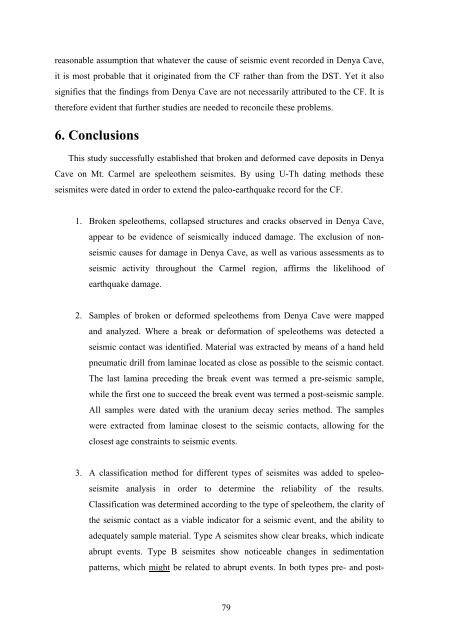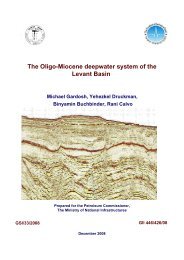tivity on the carmel faul
tivity on the carmel faul
tivity on the carmel faul
You also want an ePaper? Increase the reach of your titles
YUMPU automatically turns print PDFs into web optimized ePapers that Google loves.
eas<strong>on</strong>able assumpti<strong>on</strong> that whatever <strong>the</strong> cause of seismic event recorded in Denya Cave,<br />
it is most probable that it originated from <strong>the</strong> CF ra<strong>the</strong>r than from <strong>the</strong> DST. Yet it also<br />
signifies that <strong>the</strong> findings from Denya Cave are not necessarily attributed to <strong>the</strong> CF. It is<br />
<strong>the</strong>refore evident that fur<strong>the</strong>r studies are needed to rec<strong>on</strong>cile <strong>the</strong>se problems.<br />
6. C<strong>on</strong>clusi<strong>on</strong>s<br />
This study successfully established that broken and deformed cave deposits in Denya<br />
Cave <strong>on</strong> Mt. Carmel are speleo<strong>the</strong>m seismites. By using U-Th dating methods <strong>the</strong>se<br />
seismites were dated in order to extend <strong>the</strong> paleo-earthquake record for <strong>the</strong> CF.<br />
1. Broken speleo<strong>the</strong>ms, collapsed structures and cracks observed in Denya Cave,<br />
appear to be evidence of seismically induced damage. The exclusi<strong>on</strong> of n<strong>on</strong>seismic<br />
causes for damage in Denya Cave, as well as various assessments as to<br />
seismic ac<str<strong>on</strong>g>tivity</str<strong>on</strong>g> throughout <strong>the</strong> Carmel regi<strong>on</strong>, affirms <strong>the</strong> likelihood of<br />
earthquake damage.<br />
2. Samples of broken or deformed speleo<strong>the</strong>ms from Denya Cave were mapped<br />
and analyzed. Where a break or deformati<strong>on</strong> of speleo<strong>the</strong>ms was detected a<br />
seismic c<strong>on</strong>tact was identified. Material was extracted by means of a hand held<br />
pneumatic drill from laminae located as close as possible to <strong>the</strong> seismic c<strong>on</strong>tact.<br />
The last lamina preceding <strong>the</strong> break event was termed a pre-seismic sample,<br />
while <strong>the</strong> first <strong>on</strong>e to succeed <strong>the</strong> break event was termed a post-seismic sample.<br />
All samples were dated with <strong>the</strong> uranium decay series method. The samples<br />
were extracted from laminae closest to <strong>the</strong> seismic c<strong>on</strong>tacts, allowing for <strong>the</strong><br />
closest age c<strong>on</strong>straints to seismic events.<br />
3. A classificati<strong>on</strong> method for different types of seismites was added to speleoseismite<br />
analysis in order to determine <strong>the</strong> reliability of <strong>the</strong> results.<br />
Classificati<strong>on</strong> was determined according to <strong>the</strong> type of speleo<strong>the</strong>m, <strong>the</strong> clarity of<br />
<strong>the</strong> seismic c<strong>on</strong>tact as a viable indicator for a seismic event, and <strong>the</strong> ability to<br />
adequately sample material. Type A seismites show clear breaks, which indicate<br />
abrupt events. Type B seismites show noticeable changes in sedimentati<strong>on</strong><br />
patterns, which might be related to abrupt events. In both types pre- and post-<br />
79

















